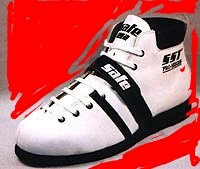Proper weight training shoes
 |
 |
Not all athletic footwear functions idealy as weight training shoes despite the fact that many a great lifts have been performed in average sneakers. The demands of most most shoes are designed for are quite different from those imposed by weight training. Furthermore, different subsets of strength training have different footwear demands. As such, strength exercise footwear should accommodate performed exercises.
Strength training imitations of typical sneakers
Most of the sneakers worn by gym patrons are designed for running/basketball/tennis/cross-training. Shoe design for these activities usually allows for flexibility and compressibility in order to allow to transition activities without having to change shoes; which is convenient in a recreational setting.
Such flexibility and compressibility, however isn't always ideal for settings in which hard-core lifting is done. While bearing and lifting heavy loads, a flexible shoe that allows too much movement of the foot can be a liability; imagine catching a jerk on ice! Excessive compressibility of a shoe can dissipate force intended to lift a load resulting in impaired reps; imagine squatting on a trampoline!
Different weight training footwear demands
Among the weight training subsets are Olympic lifting, Powerlifting, bodybuilding, rehabilitation, and performance. While the average cross-training shoe can allow for participation in any of the aforementioned subsets; optimal performance in Olympic-lifting and Powerlifting is aided by specific footwear.
Olympic lifting places force-transmission, flexibility, and stability demands on shoes. Optimal force transmission through the feet is dependant on compression resistance. To allow for split-stances, however, Olympic lifting shoes must be both flexible and durable. With these demands in mind, the Olympic-lifting shoes have hard heels, flexible toes, and tight fit.
Powerlifting footwear also requires compression resistance and stability but, unlike Olympic lifting, toe flexibility is less necessary. Compression resistant soles/heels are critical to transmitting as much force from the floor as possible. Stability. particularly around the ankle during wide stances influences both force and safety. Resultantly, powerlifting shoes have hard soles, tie/strap tight and often hi-tops.
Conclusion
As can be seen, optimal weight training shoes should reflect the exercises performed. If you're constantly performing different exercises or moving from treadmill to weights, cross trainers suffice. If, however, you want to perform optimally in ground based movements, footwear should be more specific. Factors like compressibility, flexibility, and stability must be considered. Optimal force trasmission and transfer in competitive lifting demands maximum compression-resistance and stability as well as varying degrees of flexibility.